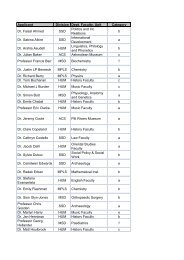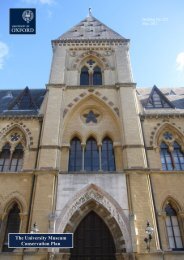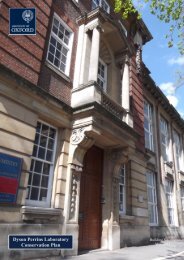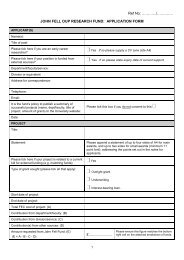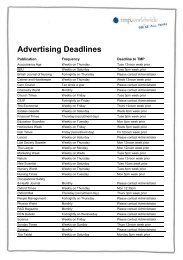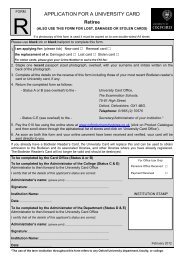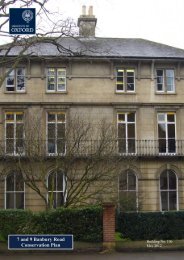The New Bodleian Library Conservation Plan - Central ...
The New Bodleian Library Conservation Plan - Central ...
The New Bodleian Library Conservation Plan - Central ...
- No tags were found...
You also want an ePaper? Increase the reach of your titles
YUMPU automatically turns print PDFs into web optimized ePapers that Google loves.
6 BIBLIOGRAPHY 377 APPENDICES 39Appendix 1: Listed Building Description 39Appendix 2: <strong>Conservation</strong> Area Description 43Appendix 3: Chronology of the <strong>New</strong> <strong>Bodleian</strong> <strong>Library</strong> 47Appendix 4: Checklist of Significant Features 49<strong>New</strong> <strong>Bodleian</strong> <strong>Library</strong><strong>Conservation</strong> <strong>Plan</strong>, April 20124
Figure 1. <strong>New</strong> <strong>Bodleian</strong> Site <strong>Plan</strong>, with the <strong>New</strong> <strong>Bodleian</strong> marked in red andthe <strong>Bodleian</strong> Complex in pink<strong>New</strong> <strong>Bodleian</strong> <strong>Library</strong><strong>Conservation</strong> <strong>Plan</strong>, April 20128
2 Understanding the Site2.1 History of the Site and University<strong>The</strong> University of Oxford has a long-standing tradition of exceptional education. Ableto trace its roots to the 11 th Century, it is known to be the oldest university in theEnglish-speaking world. <strong>The</strong> <strong>New</strong> <strong>Bodleian</strong> stands on the eastern end of Broad Street,the monumental centre of the city and the University. Broad Street has a long historyand was initially peripheral to the mediaeval settlement, being known as Canditch asit was defined by houses constructed along a ditch outside the city walls; however,Henry II granted Oxford its charter in 1155, and with the formal recognition of theUniversity, Catte Street and the eastern end of Broad Street became the centre of asmall area of ‘schools’ set up in tenements, which in turn attracted scholars fromacross Europe. Various colleges sprang up in the area during the late middle ages,notably Balliol in 1263, and with the building of the Divinity School and DukeHumphrey’s <strong>Library</strong> in 1487, the focus of the University settled on this part of thecity.Since then the principal non-collegiate buildings of the University have been situatedin a cluster around the eastern end of Broad Street, including the Sheldonian <strong>The</strong>atre(1669), the Old Ashmolean (1678-83), the Clarendon Building (1711-13), the IndianInstitute (1884-96), and the <strong>New</strong> <strong>Bodleian</strong> <strong>Library</strong> (1937-40). <strong>The</strong> Old <strong>Bodleian</strong><strong>Library</strong> (1602-1637) interacts with the space through the arch of the ClarendonBuilding. In 1703 Hawksmoor proposed the formation of a formal university campusat the eastern end of Broad Street. Whilst this never officially occurred, a similareffect has been achieved almost by default, with the urban space of eastern BroadStreet being defined by University buildings, and being a focus for ceremonies,protests, tourism, and gatherings.In April 1971 Oxford City Council designated the majority of the city centre as part ofthe <strong>Central</strong> (City and University) <strong>Conservation</strong> area, focused on Broad Street East andthe <strong>Bodleian</strong> complex (see Appendix 2).Figure 2. Aerial view of the <strong>Bodleian</strong> Complex<strong>New</strong> <strong>Bodleian</strong> <strong>Library</strong><strong>Conservation</strong> <strong>Plan</strong>, April 20129
2.2 History of the <strong>Bodleian</strong> Group<strong>The</strong> <strong>New</strong> <strong>Bodleian</strong> <strong>Library</strong> is one part of the <strong>Bodleian</strong> <strong>Library</strong> complex, whichconsists of a group of buildings at the east end of Broad Street: the <strong>New</strong> <strong>Bodleian</strong>; theClarendon Building; the Old <strong>Bodleian</strong>; and the Radcliffe Camera. <strong>The</strong>se are alsomany other libraries across Oxford which are part of the <strong>Bodleian</strong>, such as theRadcliffe Science <strong>Library</strong> and the <strong>Bodleian</strong> Law <strong>Library</strong>.<strong>The</strong> history of the library begins long before the <strong>New</strong> <strong>Bodleian</strong> was constructed. <strong>The</strong>Old <strong>Bodleian</strong> <strong>Library</strong> was first established by Duke Humphrey in 1488 with theopening of a room above the Divinity School but this had gone into decline by themiddle of the 16 th Century. In 1598 Sir Thomas Bodley funded the reinstatement ofthe library, which was opened in 1602 in the old library building and was calledBodley’s <strong>Library</strong>. This was located on the south side of Broad Street.Since the establishment of ‘legal deposit’ in 1610, whereby a copy of every bookpublished in England could be installed in the new library, the <strong>Bodleian</strong> has continuedto suffer from a lack of space. Extensions to the building were made in the 17 thCentury in an attempt to provide more space, including the Arts End and the SeldenEnd of Duke Humphrey’s <strong>Library</strong>.<strong>The</strong> Clarendon Building was constructed from 1712 to 1713 for the use of theUniversity Press. Between 1737 and 1748 the Radcliffe <strong>Library</strong> was constructed to thesouth of the <strong>Bodleian</strong> with funds from a bequest by Dr John Radcliffe, an eminentphysician of his day. It was designed by James Gibbs. This was initially a separateentity from the <strong>Bodleian</strong> but by 1860 the two were integrated and the Radcliffe<strong>Library</strong> became known as the Radcliffe Camera.Lack of space remained a problem and by 1834 there were estimated to be around220,000 books and 21,000 manuscripts in the library. Space was gained during the19 th Century by removing some of the collection to the University Galleries (now theAshmolean Museum) and through the integration of the Radcliffe <strong>Library</strong>. In 1909-12an underground book store was installed beneath Radcliffe Square. After itsconstruction the library was the largest in the world and the first to feature moderncompact shelving.This, however, only solved the problem temporarily and during the early 20 th Centurythe idea of a new, modern library was put forward.2.3 Construction and Subsequent History of the <strong>New</strong> <strong>Bodleian</strong> <strong>Library</strong>A general chronology can be found in Appendix 3.In 1925 the then Librarian of the <strong>Bodleian</strong>, Dr Arthur Ernest Cowley, informed theUniversity that the <strong>Library</strong> would run out of space in ten years’ time and began toinvestigate options for dealing with this problem. In providing a solution, a key issuewas that the University did not wish to lose the <strong>Bodleian</strong>’s association with itsbeautiful buildings in central Oxford: the Old Schools and Radcliffe Camera. Radicalalterations to the existing buildings were considered inappropriate, and it wastherefore decided that the construction of a new building, within the city centre, which<strong>New</strong> <strong>Bodleian</strong> <strong>Library</strong><strong>Conservation</strong> <strong>Plan</strong>, April 201210
could easily accommodate the growth of the library’s collections, was the best courseof action.In 1926, the Rockefeller Foundation agreed to provide three-fifths of the cost of a newlibrary, provided that the University would contribute the remainder. This was thecatalyst for the creation of a Commission, under Sir Henry Miers, which was to visitmodern University libraries in Europe and America and to report on these with theintent of informing designs for the <strong>New</strong> <strong>Library</strong>. In a report published in 1931, the<strong>Library</strong> Commission determined that the best course of action would be to abandonthoughts of a library and instead build a book-stack. <strong>The</strong> site chosen was opposite theClarendon Building, on the north of Broad Street.Following the appointment of Sir Giles Gilbert Scott as architect in June 1934, it wasdecided that the new building on the Broad Street site would be a book store andlibrary extension capable of holding approximately five million books which wouldbe connected to the Old <strong>Bodleian</strong> via a mechanical conveyor belt and pneumatic tubesystem.Construction of the <strong>New</strong> <strong>Bodleian</strong> began in December 1936, with the building workbeing conducted by Benfield and Loxley of Oxford. Thirteen 17 th -century terracedhouses on the corner of Broad Street and Parks Road had to be demolished to makeway for the building. Nos. 48 and 49, which were to be retained to the west of the site,became very unstable following the demolition of the adjacent properties and werecompletely reconstructed in 1936.<strong>The</strong> foundationstone of the <strong>New</strong><strong>Bodleian</strong> was laid byQueen Mary on 25 thJune 1937.Construction wascompleted four yearslater in 1940 to thecost of £379, 000.However, as WorldWar II had begunthe library could notbe opened and thetime was used totransfer 1.5 millionbooks over from theold library.<strong>The</strong> basement of thebuilding was alsoFigure 3. <strong>Plan</strong> of the basement use as an air raid shelterused as a militarybase and partiallyconverted into an air raid shelter during the War (though the shelter never actually hadto be put to use).<strong>New</strong> <strong>Bodleian</strong> <strong>Library</strong><strong>Conservation</strong> <strong>Plan</strong>, April 201211
Following the end of the War, the library was officially opened by King George VI ina ceremony held in October 1946. Since that time the only major alteration to thebuilding has been the addition of the Indian Institute as a south-facing roof extensionin 1966-69 by architect Robert Potter. Otherwise, the <strong>New</strong> <strong>Bodleian</strong> has remainedrelatively unchanged until 2010, with only relatively minor alterations, such assubdivision of some of the offices and the updating of some of the fixtures and fitting.<strong>The</strong> Clarendon Building became the <strong>Bodleian</strong>’s administrative centre in 1975,bringing the whole of the <strong>Bodleian</strong> complex closer together.<strong>The</strong> <strong>New</strong> <strong>Bodleian</strong> <strong>Library</strong> is described as being, ‘an experiment in working a newlibrary building into an old historic framework.’ 1 This is clear in the way that variableinfluences considered by Gilbert-Scott combine to create a unique style which is anArt Deco/Art Moderne take on Classical Revivalism. <strong>The</strong> use of materials, styles,architectural features, and design elements form a modern building in keeping withthe style of its time, though touched rather heavily by the inspiration of surroundingbuildings ranging from mediaeval timber frames to the ornate Classical Revivalism ofthe Sheldonian <strong>The</strong>atre and Clarendon Building: ‘<strong>The</strong> elevations are designed withdue respect to the traditions that produced the surrounding old buildings, but noattempt has been made to ignore modern tendencies.’ 2Figure 4. Original exterior drawing of the <strong>New</strong> <strong>Bodleian</strong>Following an extensive series of consultations (beginning formally in 2007), newalterations were started in autumn 2010. <strong>The</strong>se will dramatically change the layout ofthe ground floor of the <strong>New</strong> <strong>Bodleian</strong>, replacing the central stacks and south perimeteroffices with a new publically-accessible area including a café, and exhibition andevents space. This will be connected to Broad Street, where sections of the southernelevation between the external pilasters will be removed and a glazed wall insertedinside the building to provide an arcaded primary entrance. <strong>The</strong> entire structure of thecentral stack will be replaced with one compliant with modern building safetyregulations and more suited to its purpose.1 Edmund Craster, <strong>The</strong> <strong>Bodleian</strong> <strong>Library</strong> Extension Scheme, 1941.2 <strong>The</strong> Architect and Building <strong>New</strong>s, 30 August 1940.<strong>New</strong> <strong>Bodleian</strong> <strong>Library</strong><strong>Conservation</strong> <strong>Plan</strong>, April 201212
3 Significance of the <strong>New</strong> <strong>Bodleian</strong> <strong>Library</strong>NPPF paragraph 128 specifies that in assessing planning applications:‘Local planning authorities should require an applicant to provide a description ofthe significance of any heritage assets affected including any contribution made bytheir setting.’<strong>The</strong> significance of the <strong>New</strong> <strong>Bodleian</strong> <strong>Library</strong> has been publically recognised by twostatutory designations: It was designated a Grade II Listed building in 2003 (seeAppendix 1); and it was included in Oxford City Council’s designation of the <strong>Central</strong>(City and University) <strong>Conservation</strong> Area in 1971, and in its subsequent revisions in1974, 1981, 1985, and 1998 (see Appendix 2).3.1 Significance as part of the city centre, Broad Street, and the <strong>Central</strong> (City andUniversity) <strong>Conservation</strong> AreaAs mentioned above (Section 2.1) Broad Street East forms the monumental core ofthe city of Oxford, and is the city’s major civic meeting space. Oxford is one of themost visited places in the UK, and Broad Street is the focus for the visitor’sexperience. It is one of the most renowned and beautiful streets in Europe, with anarchitectural and cultural heritage that deserves World Status.<strong>The</strong> <strong>New</strong> <strong>Bodleian</strong> dominates the northern edge of this area, its heavy, rusticatedstone matching the gravitas of the more-venerable buildings to the south despite itsyouth. <strong>The</strong> <strong>New</strong> <strong>Bodleian</strong> is significant as a major contributing factor to the drama ofthis space, which is so integral to the significance of the <strong>Central</strong> (City and University)<strong>Conservation</strong> Area as a whole.<strong>The</strong> 2010 alterations will further integrate the <strong>New</strong> <strong>Bodleian</strong> with Broad Street Eastby replacing the wedge-shaped plinth along its southern elevation, which is currentlysimply “dead space”, with an extension of the pavement leading into the new glassfrontedcolonnade and entrance. This will create the feel of a piazza, encouragingpublic interaction with, and enjoyment of, the space. <strong>The</strong> opening up of the southfaçade, extending a managed public realm into the building, is of key importancewithin the context of the relationship between the <strong>New</strong> <strong>Bodleian</strong> and Broad Street,and ultimately between the University and the City. This will improve the setting ofthe eastern end of Broad Street, and add to the <strong>New</strong> <strong>Bodleian</strong>’s significance as amajor constituent element of one of Europe’s finest public spaces.<strong>New</strong> <strong>Bodleian</strong> <strong>Library</strong><strong>Conservation</strong> <strong>Plan</strong>, April 201213
Figure 5. <strong>The</strong> <strong>New</strong> <strong>Bodleian</strong> forms part of an axial vista with the other centraluniversity buildings<strong>New</strong> <strong>Bodleian</strong> <strong>Library</strong><strong>Conservation</strong> <strong>Plan</strong>, April 201214
3.2 Significance as part of the <strong>Bodleian</strong> Complex3.2.1 <strong>The</strong> <strong>Bodleian</strong> Complex as a single interacting monumental centre-piece<strong>The</strong> relationship between the <strong>New</strong> <strong>Bodleian</strong> and the other library buildings of the<strong>Bodleian</strong> <strong>Library</strong> complex is of primary significance. <strong>The</strong> <strong>New</strong> <strong>Bodleian</strong> waseffectively built as a self-contained library annex to the older <strong>Bodleian</strong> building andwas intended to provide storage for the library collection. It exists as part of this groupand its original King George VI entrance was designed to create an axial vista acrossBroad Street, through the archways of the Clarendon Building and the Old <strong>Bodleian</strong>to the Radcliffe Camera. This means that one can move from Radcliffe Square toBroad Street and the <strong>New</strong> <strong>Bodleian</strong> without leaving the University’s monumental core(see Figure 5).<strong>The</strong> 2010 alterations will remove the existing plinth and open up the building façade,denoting the re-orientation of the building’s new entrance. This will provide astronger spatial connection with the historical central <strong>Bodleian</strong> buildings, with themain entrance facing directly onto the Sheldonian’s public entrance. <strong>The</strong> glazedcolonnade will provide a view of the Clarendon Building and the Sheldonian fromwithin the new public foyer of the <strong>New</strong> <strong>Bodleian</strong>, further connecting the spaces.Whilst there is a physical connection between the <strong>Bodleian</strong> buildings in the form ofthe connecting tunnel under Broad Street, more significant is the intangibleconnection that exists across the entirety of the <strong>Bodleian</strong> complex. It is the idea of the<strong>Bodleian</strong> which makes all its components significant, as the <strong>Bodleian</strong> <strong>Library</strong> is (andtraditionally has been) considered the historic and academic core of OxfordUniversity. <strong>The</strong> decision in the 1920’s to build the <strong>New</strong> <strong>Bodleian</strong> in the centre ofOxford rather than build alibrary out of town makes theassociation more substantial asthe <strong>Bodleian</strong> collection remainsphysically close to the originallibrary. <strong>The</strong> pamphlet written bylibrarian Sir Michael Sadler atthe time emphasised theimportant connection betweenthe different sections of the<strong>Bodleian</strong> <strong>Library</strong>: ‘Whatever isdone, Bodley’s end of theancient <strong>Library</strong> together withDuke Humphrey’s <strong>Library</strong> andSelden End should be inviolatedFigure 6. <strong>New</strong> Broad Street entrancefollowing current alterations.[sic.]. To destroy theirassociations with the <strong>Bodleian</strong>would be vandalism.’ 33 <strong>Bodleian</strong> <strong>Library</strong> Collections, d.221, Proofs and finished copy of <strong>The</strong> Future of the <strong>Bodleian</strong> by Sir MSadler, 1926.<strong>New</strong> <strong>Bodleian</strong> <strong>Library</strong><strong>Conservation</strong> <strong>Plan</strong>, April 201215
<strong>The</strong> <strong>New</strong> <strong>Bodleian</strong> has been in place for nearly seventy years, almost the entirety ofliving memory, and has become a major element of people’s concept of the <strong>Bodleian</strong>as a whole. <strong>The</strong> significance of this will only increase with the improvements to thereading room spaces and public access to the building.3.2.2 <strong>The</strong> Significance of the <strong>Bodleian</strong> Complex as a Copyright <strong>Library</strong> andinternationally-renowned academic resource<strong>The</strong> <strong>Bodleian</strong> <strong>Library</strong> maintains its high status as a centre for academic researchbecause of its collection, which is one of the most significant of its kind, particularlythe special collections. <strong>The</strong> collection includes a wide variety of printed material,including printed books and ephemera, printed music, manuscripts, archives, andmaps. Various donors have made substantial contributions to the collectionthroughout the 500-plus year history and the status of the <strong>Bodleian</strong> as the oldestcopyright library in Britain has provided a substantial amount of material to date.According to a report outlining the future of the Collection, it is described as being a‘major component in the cultural memory of the work, and a key element in theresearch infrastructure of Oxford University, and underpins much of Oxford’s pastand present contributions to scholarship.’Notable features of the collection include: Approximately 7,000 incunabula (books printed before 1501).<strong>The</strong> John Johnson Collection of over one million items from the 18 th , 19 th , andearly 20 th Centuries.<strong>The</strong> Western Manuscripts Collection, which is the second largest in Britain withitems ranging in date from the 3 rd Century BC to the present day.A comprehensive map collection.Important individual items include:<strong>The</strong> Magna Carta, 1215. A copy of the charter between King John and his Barons,which importantly stated that the King was subject to the law, not above it.<strong>The</strong> Ashmole Bestiary, late 12 th or early 13 th Century. An English illuminatedmanuscript bestiary which contains a creation story and detailed allegoricaldescriptions of over 100 animals.<strong>The</strong> Romance of Alexander, 1338-44. An illustrated manuscript by Flemishilluminator Jehan de Grise depicting the legends of Alexander the Great.<strong>New</strong> <strong>Bodleian</strong> <strong>Library</strong><strong>Conservation</strong> <strong>Plan</strong>, April 201216
Figure 7. Detail from the Ashmole BestiaryAs an academic resource the <strong>Bodleian</strong> has world-wide significance and renown, builtover a 500 year heritage.<strong>The</strong> <strong>New</strong> <strong>Bodleian</strong>’s rôle is paramount to the significance of the <strong>Bodleian</strong> as a whole,as its stacks provide their primary storage space. <strong>The</strong> 2010-15 alteration works willhave a positive impact on the significance of the collections by bringing their storageconditions in line with modern archive storage standards, e.g. BS5454:2000"Recommendations for the storage and exhibition of archival documents."3.3 Historical Significance3.3.1 Bodley Boys‘Bodley Boys’ were apprentices at the library who worked in exchange for auniversity education funded by the <strong>Bodleian</strong>. This scheme was set up in the 1880’sand only lasted a short time after the <strong>New</strong> <strong>Bodleian</strong> had opened. <strong>The</strong> former BodleyBoy, Ted Parsons, was however instrumental in establishing a modern mapdepartment at the <strong>Bodleian</strong> and planned the map library for the <strong>New</strong> <strong>Bodleian</strong>. <strong>The</strong><strong>New</strong> <strong>Bodleian</strong> also saw the appointment of the first Bodley Girl, Sasha Wernberg-Møller, in 1949.3.3.2 Dr Arthur Earnest Cowley and Sir Edmund CrasterOf great importance to the <strong>Bodleian</strong> has always been the head librarian. <strong>The</strong> ability tooversee such a large and prodigious library is a formidable task. <strong>The</strong>se men, and nowwomen, have had a significant impact on the physical planning and operation of thelibrary and on the lives of many of its users.Two librarians in particular have shaped the design of the <strong>New</strong> <strong>Bodleian</strong>; Dr ArthurEarnest Cowley was the librarian who, in 1929, forewarned the <strong>Bodleian</strong>’s Curatorsthat the library was swiftly running out of space; Sir Edmund Craster was a major<strong>New</strong> <strong>Bodleian</strong> <strong>Library</strong><strong>Conservation</strong> <strong>Plan</strong>, April 201217
figure in the development of the <strong>New</strong> <strong>Bodleian</strong>, taking part in the first discussionsabout the design, site, and appointment of Sir Giles Gilbert Scott, and later in theinternational tours. Craster later wrote a history of the <strong>Bodleian</strong> <strong>Library</strong> from 1845-1945 and was the only <strong>Bodleian</strong> Librarian ever to be knighted.3.3.3 <strong>New</strong> <strong>Bodleian</strong> during the War<strong>The</strong> opening of the <strong>New</strong> <strong>Bodleian</strong> was delayed because of the advent of World WarII. As well as transferring the <strong>Bodleian</strong>’s collection into the bookstack during the War,the building was also used as a public air raid shelter and military base. A brickshelter was built on the lowest level of the library with space for 1,100 people, thoughit was never actually used and all trace of it was demolished after the war (see Figure4, above).<strong>The</strong> perimeter rooms of the library were also used during the War by the military butit is unclear to what extent or exactly what tasks were carried out in them. It is thoughtthat a naval photographic record was compiled here through photos of the coast sentin by citizens and that the War Organisation of the British Red Cross Society andOrder of St John Jerusalem occupied a room for use as a Prisoners of War department.<strong>The</strong>re is no obvious physical or archaeological evidence related to military use,though a number of utilitarian furnishings, such as metal desks or chairs, could beremnants of standard-issue military furniture. Also during the War the <strong>New</strong> <strong>Bodleian</strong>was used as a safe house for the King’s <strong>Library</strong> Collection.<strong>The</strong> use of the building during the War is of interest, especially the construction of theunderground shelter, as is the storage of the King’s <strong>Library</strong> Collection; however, thisdoes not appear to have a real significance in terms of the library building today.While the air raid shelter is a unique example of a temporary conflict shelter, none ofthe original structure remains.3.4 Archaeological Significance<strong>The</strong>re can be no archaeology left behind beneath the <strong>New</strong> <strong>Bodleian</strong> in the form ofphysical remains as substantial demolition and excavation was necessary toaccommodate the three underground bookstack levels, which presumably led to thecomplete annihilation of the archaeological record. <strong>The</strong> only archaeologicalsignificance lies in the methodology and subsequent conclusions of the investigationsundertaken at the time of the new building by Dr William Pantin to record the abovegroundbuildings archaeology of the houses previously on the site, and by Dr. RupertBruce-Mitford to retrieve and record mediaeval archaeological finds from the siteprior to the building of the library. Rupert Bruce-Mitford’s investigations formed thefirst urban ‘rescue investigation’, now common practice in commercial archaeology,and the 1, 346 pottery sherds recovered from the site formed the basis for the firstmodern study of mediaeval pottery.<strong>New</strong> <strong>Bodleian</strong> <strong>Library</strong><strong>Conservation</strong> <strong>Plan</strong>, April 201218
3.5 Architectural Significance3.5.1 Sir Giles Gilbert ScottSir Giles Gilbert Scott’s design for the <strong>New</strong> <strong>Bodleian</strong> <strong>Library</strong> has a very distinctivestyle which employs both historic and modern architectural elements. <strong>The</strong> designdetails were used in an attempt to create a stylised building which draws from itssurroundings, wherein the Classical idiom is predominant but a modern design couldalso be applied. This has at times been criticised as neither being of one style nor theother, and the use of rubble stone was also not considered appropriate for the setting.<strong>The</strong> unusual design of the <strong>New</strong> <strong>Bodleian</strong> is, however, very distinctive and wasdescribed by contemporaries as expressive of a particular approach: ‘Consideredgenerally, the building is representative of the characteristically English school whichcontrives to make the best of both worlds, functional and neo-classical.’ 4 Scott’seclectic amalgamation of historic and modern can be seen as a prime example of thetransition of architecturalstyles between the twoWorld Wars, or as abacklash to the overly plainform of Bauhaus modernismwhich was emerging inEurope at the time.Figure 8. Sir Giles Gilbert Scott in 1933 (aged53)Sir Giles Gilbert Scott isnow considered one of thegreat architects of his timeand not just the last of a longline of remarkable architects.His work combines historicdetails of both the Classicaland Gothic styles, intobuilding designs that areessentially functional, suchas the Battersea andBankside power stations andthe Cambridge University<strong>Library</strong>. He remainedthroughout his career anarchitect wedded to the‘middle line’: the synthesisof historic style with modernbuilding techniques andfunctional design. He is, however, possibly most well known for the reconstruction ofthe House of Commons after it was bombed during World War II. Here Scott carriedout the rebuilding in an entirely traditional style.4 <strong>The</strong> Architect and Building <strong>New</strong>s, 1936.<strong>New</strong> <strong>Bodleian</strong> <strong>Library</strong><strong>Conservation</strong> <strong>Plan</strong>, April 201219
Scott is undoubtedly one of the major figures of 20 th -century architecture in theUnited Kingdom. His work may have seemed old fashioned by the 1930’s and 1940’sbut it has an enduring quality that is now appreciated by the many millions of visitorsto the Tate Modern (22 million between 2000 and 2005) and to Liverpool’s AnglicanCathedral. <strong>The</strong> <strong>New</strong> <strong>Bodleian</strong> is a simple building compared to some of Scott’s majorworks, but is nevertheless a fine example of his particular style.3.5.2 Design for Function<strong>The</strong> design and original layout is of some significance, mostly due to itsserviceability. <strong>The</strong> layout of the central bookstack surrounded by rooms created adistinction between areas for storage and areas for public use. <strong>The</strong> library originallyfunctioned well, with the easily accessible bookstack and book conveyer fortransportation, via the underground tunnel, to the Old <strong>Bodleian</strong>.<strong>The</strong> layout and functionality of the <strong>New</strong> <strong>Bodleian</strong>’s original design were not unique.<strong>The</strong> design was influenced by the buildings seen by Sir Giles Gilbert Scott and SirEdmund Craster on their tour of other libraries in Europe and America where theseinnovative designs were already in use. <strong>The</strong> central stack system was influenced bythe libraries at Yale and Columbia.<strong>The</strong> significance of design and layout of the <strong>New</strong> <strong>Bodleian</strong> <strong>Library</strong> has always beenreliant on the influence of Scott and Craster. For the most part this influence will beretained by the ongoing alterations, with the central stack being reinterpreted as a‘floating’ stack which provides functional storage space whilst freeing up as muchfloor space as possible, just as Scott’s original central and basement stackarrangement sought to do.3.5.3 Totality of DesignOne of the most remarkable features of the <strong>New</strong> <strong>Bodleian</strong>’s original design is itsattention to detail. This consideration spans from the use of high-quality materials inboth public and private space, to the design of a number of elements specifically foruse in the building. Scott went so far as to design details such as door knobs andhandles. All of the architectural detailing is particular to the building, such as thecarved stone cornices and stone cartouches found on the exterior of the building.Much of the original furniture and fittings were also designed by Scott, such asreading tables, chairs, and also one-off pieces such as the conference table for theCommittee Room. Many of the original design drawings for the furniture andironmongery, plus a furniture schedule, survive in the <strong>Bodleian</strong> archive.It is difficult to find examples of other buildings by Scott where he paid such anoverarching attention to detail, though he did design fittings and finishes for several ofhis schemes; for example, at the church of Our Lady and St. Aphege, Bath, hedesigned a tessellated linoleum floor which gave the appearance of patterned marble.<strong>New</strong> <strong>Bodleian</strong> <strong>Library</strong><strong>Conservation</strong> <strong>Plan</strong>, April 201220
Figure 9. Original desks in PPE Reading RoomIn the early 20 th Century the practice of designing furniture and fittings for a buildingwas popular among several other architects. Charles Rennie Mackintosh (1868-1928)did so for the Willow Tea Rooms in Glasgow (1903-05), where he designed theinteriors, willow-leaf patterned windows, and a version of his iconic back chairs.Frank Lloyd-Wright (1867-1959) also advocated ‘totality’ of design and applied thisto his buildings such as the Johnson Wax Administration Building, Racine,Wisconsin, USA (1936), where he designed all the office furniture.<strong>The</strong> ongoing alterations will modify the design as pertains to parts of the southernelevation and the ground floor, where the stack will be replaced with an entrance hall.However, across the majority of the building the original design will be retained withmostly later partition walls being removed.3.5.4 <strong>New</strong> <strong>Bodleian</strong> as a ‘Complete Artefact’Despite the ongoing alterations the interior of the <strong>New</strong> <strong>Bodleian</strong> remains remarkablyintact, with the public areas remaining very close to their original design and layout.Throughout the building very few floor finishes and original light fittings are extant,but otherwise the majority of the public areas and some of the private areas of theinterior remain remarkably intact, with survivals such as: veneer doors and theirhardware; cast iron radiators; Taynton stone decoration; and aluminium windows.Another notable survival is the amount of high-quality original furnishings, such asreading tables, desks, chairs, and bookshelves. <strong>The</strong>se were often designed forindividual rooms but in many cases have been dispersed around the building or intostorage. Many of the original fittings, such as the brass plug sockets and lightswitches, remain in place but are unfortunately redundant and have modern plasticfittings crudely positioned over them. Finally, there are numerous small pieces, suchas timber book stands, filing trays and bins that add to the rich collection of architectdesignedfurnishings.<strong>New</strong> <strong>Bodleian</strong> <strong>Library</strong><strong>Conservation</strong> <strong>Plan</strong>, April 201221
<strong>The</strong> most complete scheme is in the main Reading Room (now the PPE ReadingRoom) which retains its sapele mahogany bookcases, reading desks, light fittings,clocks, issue desk (which has been modified, but will be returned to its original formduring the ongoing alterations), and a splendid inlaid wood ceiling. <strong>The</strong> adjacentIndex Gallery (now the PPE Gallery) also retains many original features, such asbronze doors and the Taynton stone cornice. <strong>The</strong>se two rooms were designed asprominent public rooms and are both of high significance. Room 206 (Rare Booksand Printed Ephemera) is another important space owing to the retention of theoriginal cork floor (which if possible will be retained during ongoing alterations),glass light fittings, bookcases, and conference table. Other important rooms includethe main entrance hall, the King George entrance, stairs 1 and 4, the Music ReadingRoom, and the Oriental Reading Room. For fuller details of these principal areas, andtheir condition following the ongoing alterations, see Section 4.3.A perusal of Purcell Miller Tritton’s 2006 Gazetteer of the <strong>New</strong> <strong>Bodleian</strong> <strong>Library</strong>,read alongside section 4 of the Heritage Impact Assessment, gives a comprehensiveindication of the surviving original material in the building.Whilst the ongoing alterations will update the stacks and modify the atmosphere ofthe entrance area, the experience of the reader working within the reading rooms willbe largely unchanged from 65 years ago. <strong>The</strong> current and future generations ofscholars will use the same chairs at the same desks as the first users of the building inthe 1940s. <strong>The</strong> survival of so much of the furniture and of the original fittings makesthis a special building and a particularly good example of Scott’s work.<strong>New</strong> <strong>Bodleian</strong> <strong>Library</strong><strong>Conservation</strong> <strong>Plan</strong>, April 201222
4 Vulnerabilities4.1 <strong>The</strong> Ability of the <strong>New</strong> <strong>Bodleian</strong> to provide world-class academic resources<strong>The</strong> way in which the <strong>New</strong> <strong>Bodleian</strong> relates to the other buildings and effectivelyservices them is vital to the significance of the building and the complex as a whole.To risk losing the library use on the <strong>New</strong> <strong>Bodleian</strong> site is to risk ‘ripping the heart’ outof academic Oxford with the Old <strong>Bodleian</strong> <strong>Library</strong> and the Radcliffe Camera ceasingto be major academic centres.<strong>The</strong> ongoing alterations will bring the <strong>New</strong> <strong>Bodleian</strong>’s book storage facilities up tomodern standards, so ensuring that the significance of the site in this area ismaintained.4.1.1 Environmental ControlIn terms of temperature and relative humidity the 2010 alterations will bring the <strong>New</strong><strong>Bodleian</strong>’s book storage facilities in line with BS5454:2000 "Recommendations forthe storage and exhibition of archival documents." This will allow the <strong>New</strong> <strong>Bodleian</strong>to remain an “approved repository” to the standards required by the NationalArchives; however, due to the significance and vulnerability of the collection this willalways require constant vigilance and updating based on changing technologies andstandards.4.1.2 Security<strong>The</strong> value of the <strong>Bodleian</strong>’s collections will inevitably attract thieves, as a series ofhigh-profile thefts in the last 10 years highlights. <strong>The</strong> current alterations will allowpublic access to the building for the first time. This will introduce new security riskswhich will be somewhat mitigated by the introduction of “security access zones”,based on a hierarchy of public-reader-staff.Public access is untested in the <strong>Bodleian</strong> and the effects of the policy will have to beconstantly monitored to achieve the optimum security results.4.1.3 Fire ProtectionWith a manuscript collection of such size and significance fire safety will always bean important priority. <strong>The</strong> ongoing alterations will remove many of the existing fireprotection weaknesses within the stack, to the extent that the fire protection standardsfor the safeguarding of the archives will be more stringent than the relevant BuildingRegulations. <strong>The</strong> water-mist fire suppression system poses some risk to the archives,but this will be lower than other systems, and is the most effective protection againstthe greater risk of fire.4.1.4 Flood/Damp Protection<strong>The</strong> new basement stack will be protected from ground water ingress by externalconcrete slabs with minimal penetrations. However, the rainwater pipes in thebuilding remain internal, making them difficult to access for maintenance. Internal<strong>New</strong> <strong>Bodleian</strong> <strong>Library</strong><strong>Conservation</strong> <strong>Plan</strong>, April 201223
ainwater pipes are a problem in any building but a particular problem in a buildingwith a valuable collection because the risk of blocking and flooding is unacceptablyhigh.<strong>The</strong> piping will be inspected during the current alterations and if found to be soundwill continue in use, though proper monitoring systems should be put in place.4.2 Interior Decorations, Furnishings, Fixtures, and FittingsMany of the original internal decorations, furnishing, fixtures, and fittings are extantand in use. <strong>The</strong>se are integral to the overall feel and architectural significance of theasset and many were designed by Sir Giles Gilbert Scott or his office. As they are inconstant use and of less permanent construction than the external structure of thebuilding, they are more vulnerable to vandalism, accidents, and general wear and tear.Some of these issues should be mitigated assuming adequate security is in place, andespecially considering that the most significant areas are not subject to public access,but ultimately these significant elements will have a limited lifespan.As a Grade II listed building any interior alterations, or repairs made with nonoriginalmaterials, will require listed building consent.4.3 Principal Spaces<strong>The</strong>re are a number of interior spaces of particular significance, either because of thequality of their design or their state of preservation. <strong>The</strong>se spaces are integral to the<strong>New</strong> <strong>Bodleian</strong>’s significance as a heritage asset. Each has particular elements, eitherrelating to their architecture, fittings, or furnishings, that contribute substantially tothe significance of the site as a whole. <strong>The</strong>y are vulnerable to the same issues as theother interior spaces but their damage or loss pose greater potential consequences forthe heritage asset as a whole.Brief descriptions of their probable conditions following the ongoing alterations (i.e.c.2015) are given below:4.3.1 Parks Road Entrance<strong>The</strong> walls of the Parks Road entrance are covered in their original Taynton stoneblock veneer to almost ceiling height, with an incorporated carved cornice composedof classical top moulding and a frieze of stylised acanthus leaves. <strong>The</strong> adjacentcorridor to the west is separated by two pilasters and a pair of square pillars, all withcapitals featuring the same frieze as the adjacent cornices, which have all been lightlycleaned. <strong>The</strong> two central pillars feature an applied art-deco style vase decoration. Alarge window with a carved stone surround links the entrance with the Security Roomto the south. <strong>The</strong>re are two wood benches supported by carved stone bases on eitherside of the small east vestibule area, as well as a stone display cabinet integrated intothe north wall. <strong>The</strong> patterned linoleum floor is a new replacement sympathetic withthe original fabric, and the light fixtures are replicas of the original woodenchandeliers.<strong>New</strong> <strong>Bodleian</strong> <strong>Library</strong><strong>Conservation</strong> <strong>Plan</strong>, April 201224
4.3.2 Broad Street VestibuleThis previously-defunct area is now the entrance to the Admissions Office. As SirGiles Gilbert Scott intended this to form one of the major entrances to the building, itwas designed to be of the highest quality. <strong>The</strong> room has a barrel vault ceiling withhalf-domes at either end. <strong>The</strong> walls are Taynton stone veneer with an acanthus leafcornice, typical for the building, with the addition of a half-round pedestal at eitherend. Two large moulded wooden doors open onto the space from Broad Street.4.3.3 East Corridor<strong>The</strong> east corridor was intended to be the main public passage, as both original mainentrances opened onto it; as such it was finished to a high standard. <strong>The</strong> walls arecovered in Taynton stone veneer with an incorporated plain stone cornice. Above thecentral stack door on the west wall, integrated into the veneer, are two winged horseseither side of a floral motif clock. <strong>The</strong> large doorways into the adjacent corridors eachhave a carved stone surround with decorated cornice, while all other doors have asimple stone surround. A large window with detailed, built-out stone surround linksinto the Security/Cloak Room, though it is now disused. Some original stonework hasbeen removed where three new openings at the southern end link the space to the newentrance hall. <strong>The</strong> light fittings and flooring are new alterations sympathetic to theoriginal design, and the original stone has all been newly cleaned and restored.4.3.4 Stair 1Stair 1, located in the northeast corner of the building, was not extraordinary incomparison to the rest of the building at the time of construction. As with the otherstairs there is: a dado rail of Taynton stone veneer with painted plaster walls above; agilted metal balustrade of a detailed art-deco-style design with a carved hardwoodhandrail; and tall, multi-paned double-storey aluminium-alloy windows. What makesStair 1 a significant space now is that it retains the only surviving cork floor finishwhich all of the stairs originally contained. <strong>The</strong>re has been a substantial amount ofreplacement with more modern cork flooring, especially between the ground and firstfloors (which is well travelled space), but the newest replacements are sympathetic tothe original design; however, in the basement levels as well as at the second floor, theoriginal floor finish has been refurbished and remains in place. <strong>The</strong> original brass andglass light fittings have been newly refurbished and refitted (they had previously beenin storage), and the Taynton stone veneer has been refurbished throughout.4.3.5 Stair 4Stair 4 is unique from the other stairwells in that it features predominantly on theexterior of the building. Located at the southeast of the building, it is immediately tothe west of the ceremonial Broad Street doorway and forms a kind of turret on themain corner of the building. This stairwell with its tall, thin aluminium window, alongwith the curved corner and stepped building levels, is part of what gives Scott’sdesign such a modernist feel. Aside from its half-round plan, the interior of this stair issimilar to the other 3 major stairs. <strong>The</strong>re is a Taynton stone dado and gilted metalbalustrade. <strong>The</strong> original brass and glass light fittings have been newly refurbished andrefitted (they had previously been in storage), the linoleum floor has newly been<strong>New</strong> <strong>Bodleian</strong> <strong>Library</strong><strong>Conservation</strong> <strong>Plan</strong>, April 201225
eplaced with cork sympathetic to the original design, and the Taynton stone veneerhas been refurbished throughout.4.3.6 Rare Books and Printed EphemeraThis space remains one of the most complete in the building, as it still retains much ofits original interior features and furniture, which have all been newly restored. Thisincludes the cork floor tiles (as installed by Korkoid) and 4 cut-glass light fixtures.While these light fixtures may have originally been found in a number of rooms in theouter block (photographs from the 1940s show them in the Exhibition Room on theground floor), it is thought that this is the only room where they remain in situ. <strong>The</strong>room also houses a number of bookcases, likely original to the building, butquestionably original to the room. One of the most remarkable features of the room isa large Art-Deco style conference table which features an inlaid burl veneer top. <strong>The</strong>table was designed to be adjustable in length, with concealed slot handles at eitherend. While drawings show a number of chairs with half-round backs, they are nolonger with the table and it is unsure whether they were ever made. <strong>The</strong> originalsecretary’s desk from the Index Gallery (now the PPE Gallery), which has a lighterinlaid burl veneer and a reed-and-fillet band on the edges of the desktop, has beenrelocated to this room.4.3.7 PPE Gallery<strong>The</strong> PPE Gallery, which was originally the Index Gallery (intended to hold thecatalogue) is adjacent to the PPE Reading Room and was designed to form a grandpoint of entry to the Reading Room. It is unique due to its structure, as it is the onlyroom of the outer block which is actually located within the structure that previouslyheld the original stacks. Due to this layout, there was an inability to place windows onthe outer wall, and so the space is lit by skylights (that have been newly unblocked toreplace intrusive strip lighting). A new floor finish, sympathetic to the originalpatterned cork design, has been added to replace intrusive carpet tiles. Screen walls ateither end of the room consist of restored, original square Taynton stone pillars withcarved capitals and bronze doors and windows with decorative brattishing above.<strong>The</strong>re is a carved stone cornice running around the room which is of a stylised Neo-Egyptian style. Prior to the 2010-15 alterations this room was out of use, but it is nowemployed as a reading room.4.3.8 PPE Reading RoomThis room, located at the north side of the first floor, is arguably the most significantspace in the building. <strong>The</strong> room remains almost entirely as built, aside from newlyfitted floor finishes (sympathetic to the original cork design), and the blocking of thewesternmost door. <strong>The</strong> large wooden issue desk is original and has been newlyrestored to its original specifications (it had previously been extended from its originalL-shape to a U-shaped circulation desk) and has been installed in the centre of thenorthern wall.<strong>The</strong> most striking original feature of the room is the inlaid wooden ceiling, whichmimics Native American or African designs in a stylised Art Deco manner. It isthought that the various types of wood were actually gathered from various British<strong>New</strong> <strong>Bodleian</strong> <strong>Library</strong><strong>Conservation</strong> <strong>Plan</strong>, April 201226
Commonwealths existent at the time of construction. <strong>The</strong>re are a number of newlyrestoredoriginal reading desks with carved leg supports and table-top dividers. <strong>The</strong>se,as well as a number of easy chairs and several tapered wood rubbish bins with metalliners, are original to the room. 2 of the original unique geometric wooden chandeliersremain at the eastern of the room.Figure 10. PPE Reading Room in 2010. Note inlaid woodceiling and original desks.<strong>New</strong> <strong>Bodleian</strong> <strong>Library</strong><strong>Conservation</strong> <strong>Plan</strong>, April 201227
This Page Has Been Left Blank<strong>New</strong> <strong>Bodleian</strong> <strong>Library</strong><strong>Conservation</strong> <strong>Plan</strong>, April 201228
5 <strong>Conservation</strong> PolicyHaving established the significance of the <strong>New</strong> <strong>Bodleian</strong> as a heritage asset, andhaving identified ways in which the significance of the <strong>New</strong> <strong>Bodleian</strong> is vulnerable toharm, it is necessary to recommend policies to reduce the probability of such harmoccurring and thereby conserve the significance of the site. In essence, these policiesset parameters for managing the fabric of the site.<strong>The</strong> <strong>Conservation</strong> <strong>Plan</strong> is intended as an active tool for the regular maintenance andlong-term management of the <strong>New</strong> <strong>Bodleian</strong> <strong>Library</strong>. It needs to be reviewedregularly, and revised as appropriate to take account of additional knowledge andchanging priorities. Through a process of regular review it should continue to act as auseful resource.5.1 Permit, in line with NPPF paragraphs 131, 132, 133, and 134, such alterations asare necessary to allow the continued use of the <strong>New</strong> <strong>Bodleian</strong> Building as aworld-class library and as a major stack storage space. Any proposals for thedevelopment of the site will facilitate this optimum viable use<strong>The</strong> significance of the <strong>New</strong> <strong>Bodleian</strong> as a constituent element of the <strong>Bodleian</strong>Complex means that its rôle as a library represents its optimum viable use. <strong>The</strong>ongoing alterations make impressive improvements in the areas of storage,environmental control, fire safety, and security. As these will address most currentconcerns, major alterations will not be a pressing issue for the time being, but thisshould be the over-riding principal in any future assessments or <strong>Conservation</strong> <strong>Plan</strong>s. Ifalteration is required in the future it should be permitted with the following provisos: Any alterations must be sympathetic to the <strong>New</strong> <strong>Bodleian</strong> <strong>Library</strong>’s significance asa heritage asset and, in line with NPPF paragraph 134, any proposals that involve‘less than substantial harm to the significance’ should deliver ‘substantial publicbenefits.’ In line with NPPF paragraph 132, any proposals that involve ‘substantialharm or loss’ should be ‘exceptional.’ Any changes should: ‘…preserve those elements of the setting that make a positivecontribution to or better reveal the significance of the asset’ (NPPF paragraph 137).5.1.1 In order to ensure that the <strong>New</strong> <strong>Bodleian</strong> can operate to modern standards, andthat its significance can be maintained by making access as wide as possible,special concern should be applied to ensuring that disabled access is adequateEnsuring that the heritage asset can be enjoyed as widely as possible will have a majorpositive impact on its significance. Ongoing alterations will bring disabled access upto acceptable modern standards, e.g. new accessible lifts (see section 11 of Design andAccess Statement), and this should remain a major concern in any further alterations.<strong>New</strong> <strong>Bodleian</strong> <strong>Library</strong><strong>Conservation</strong> <strong>Plan</strong>, April 201229
5.2 Any redevelopment needs to respect the <strong>Conservation</strong> Area and the library’ssetting adjacent to several important listed buildingsIt has been established that the <strong>New</strong> <strong>Bodleian</strong> is significant as an integral aspect of theUniversity’s monumental centre at Broad Street East. Any future alteration should besympathetic to this fact, and should not diminish its rôle there.5.3 In the vein of NPPF paragraph 110, efforts should be made to ensure that the<strong>New</strong> <strong>Bodleian</strong> <strong>Library</strong>’s contribution to climate change is as minimal as isfeasible for a building of its age, size, materials, and use. Any proposals foralterations should assess the feasibility of incorporating low and zero carbontechnologiesEnsuring that the building is sustainable will be crucial to its long-term survival andsignificance. As stated in NPPF paragraph 110, development should seek to‘minimise pollution and other adverse effects on the local and natural environment.’5.4 Note that the <strong>New</strong> <strong>Bodleian</strong> is a listed building and ensure that appropriateconsents are obtained for any alteration works to the interior or exterior of thebuilding<strong>The</strong> ongoing alterations should preclude the need for any significant changes in thenear future, but due to the listed status of the building even minor routine repairs mayneed consent. Caution should be applied in order to ensure that any statuary duties arefulfilled. In cases of doubt Oxford University’s Estates Directorate should becontacted in the first instance, and if necessary they will refer queries on to OxfordCity Council.5.4.1 Ensure proper consultation in advance of any work to the building with theLocal Authority <strong>Conservation</strong> Officer and any other interested partiesThis is to ensure that the best advice is obtained at an early stage of any proposal toalter any part of the building in order to make certain that the significance of thebuilding is respected.5.4.2 Refer to the detailed gazetteer of the building, produced by Purcell MillerTritton LLP, when considering repairs or alterations in any space<strong>The</strong> Gazetteer gives an overview of what remains in the building and what issignificant, prior to the latest alterations. When used in conjunction with the HeritageImpact Assessment, it should be clear where original material remains. Where originalor significant material is extant, repairs should be carried out using the same materialsand techniques and should not affect the significance of the asset without providingsubstantial public benefits in line with NPPF paragraph 134.5.5 <strong>Conservation</strong> of specific attributes contributing to overall significanceMany of the spaces in the building retain much of their original finishes and furniture.<strong>The</strong>se finishes should be identified and conserved and kept in use where possible in<strong>New</strong> <strong>Bodleian</strong> <strong>Library</strong><strong>Conservation</strong> <strong>Plan</strong>, April 201230
line with Section 5.1. It is accepted, however, that all these materials have a naturallife span and some degree of change must be permitted to keep the building safe,useable, and generally fit for its primary purpose as a working library and book store.Some materials such as the stone used for the internal wall surfaces have a very longlife expectancy if given minor maintenance, others such as the flooring, have largelybeen replaced with sympathetic equivalents. Within the framework of understandingand valuing what is present in the building a degree of ongoing change is inevitable.5.5.1 Following the current alterations, the external façades of the building willremain substantially unchanged<strong>The</strong> three façades are a key element of Scott’s design and are part of the streetscape inthe centre of the <strong>Conservation</strong> Area. Changes to these elevations will significantlyaffect the character of the building. <strong>The</strong> northern and western facing façades willremain unchanged from their original design. Ongoing alterations will significantlymodify the main southern elevation by removing some of the walls, pilasters, andwindows, and incorporating a new glass-fronted entrance. <strong>The</strong>se changes, which arein line with Section 5.1 will realise the potential of the original design by introducinga monumental entrance in its intuitive location on the building’s chief elevation, andhave a major positive impact.5.5.2 <strong>The</strong> aluminium windows and the glazing pattern are a significant part of thebuilding design. Following the current alterations, the windows should beretained and conserved or where this is not practicable new glazing should followthe pattern of the present glazing. <strong>The</strong> feasibility of improving the energyefficiency of the existing glazing without impacting on their significance shouldbe assessedWhere extant, these windows are the original windows and a key part of the overalldesign. In line national policy and the University’s own climate change objectives it isdesirable to improve the energy performance of these features. <strong>The</strong> feasibility ofperforming such alterations whilst minimising the impact on the significance of thefeatures should be assessed.5.5.3 To take note of the surviving finishes in both the principal rooms and thecirculation area of the building and to ensure that these are retained andconserved where this is possible and practicalMany of the original finishes to walls and ceilings, and in some limited areas floors,remain in place. Where possible these should be retained and should not be removedwithout proper consideration of their value and listed building consent. Wherepossible in the principal areas of the building the finishes should be conserved andretained where this is practicable.<strong>New</strong> <strong>Bodleian</strong> <strong>Library</strong><strong>Conservation</strong> <strong>Plan</strong>, April 201231
5.5.4 Where ongoing alterations allow, ensure that extant original furnishings arecatalogued, related to specific rooms, and repaired and retained in use wherefeasibleMany of the items of furniture are contemporary with the building and were designedfor the rooms by Scott or his office. <strong>The</strong> scope of the furniture includes reader’sdesks, tables, and chairs. <strong>The</strong>se have become dispersed over the years and are now inurgent need of overhaul or repair. Groups of furniture should be kept together wherein possible in the room for which they were designed.5.5.5 Where ongoing alterations allow, conserve and retain extant original fixturesand fittings in the public areas of the buildingAs with the loose furniture, many of the fitted elements of the building were purposedesigned for the spaces. This includes fitted counters, light fittings, and door furniture.5.5.6 To ensure that the remaining original light fittings in the reading rooms andoffices are identified and retained<strong>The</strong> majority of the light fittings have been altered but a small number of originalsremain which should be retained, rewired, and conserved. <strong>The</strong>se can be found inPurcell Miller Tritton’s gazetteer and in the Heritage Impact Assessment (where theywill be replaced in the current alterations). <strong>The</strong> other light fittings in the building areof little significance.5.5.7 Maintain specific vulnerable and architectural elementsAs identified in Section 4.3, there are specific areas of significance that areparticularly significant and vulnerable. <strong>The</strong>se should be treated with special cautionand maintained to as high a standard as possible. Any further restoration or alterationof these will require listed building consent. Any repairs may need listed buildingconsent and Estates Services should be consulted prior to undertaking any such work,if appropriate they will pass queries on to Oxford City Council.5.5.7.1 Retain the remaining features of the Parks Road entrance of the building, itsfinishes, layout, and furnishingsThis is one the primary spaces of the building where a good deal of attention has beengiven to the quality of the design. <strong>The</strong> entrance sets the scene for the interior ofScott’s building.5.5.7.2 Retain the two staircases numbers 1 and 4 in the southeast and northeast cornersof the buildings to their full height. <strong>The</strong> design, layout, fittings, and finishes arelargely original and should be conserved<strong>The</strong> public stairs are a key part of Scott’s design for the building. <strong>The</strong>se two stairsretain most of their original finishes and relate to the entrance and circulation corridor.Whilst they will be partly superseded by new staircases running the full height of thealtered structure, they still form a key part of the experience of moving around thebuilding.<strong>New</strong> <strong>Bodleian</strong> <strong>Library</strong><strong>Conservation</strong> <strong>Plan</strong>, April 201232
5.5.7.3 Retain the furniture, fittings, and finishes in the Rare Books and PrintedEphemera Room (originally the Committee Room)This room, originally the Committee Room, retains a considerable amount of theoriginal interior finishes and fittings including the handsome committee table andsecretary’s desk. This should be conserved as a good example of the original interior.5.5.7.4 Retain the furniture, fittings, and finishes in the PPE Reading Room (originallyknown just as ‘<strong>The</strong> Reading Room’)Whilst superseded by the new entrance hall as the primary public space in thebuilding, this remains the primary reading room, and the most significant space interms of original fixtures, fittings, and layout. Much of the room retains its originalcharacter including the splendid inlayed timber ceiling, light fittings, clocks, librariescounter, doors and ironmongery, and much of the original furniture. Many smallerpurpose-designed articles also survive such as the trays for book order slips and theperpetual calendar. <strong>The</strong> interior of this room can be maintained much as it would haveappeared when first opened.5.6 If during any subsequent renovations or alterations any evacuation work iscarried out under the edges of the roadways to the north and west of the buildingan archaeological assessment will be made of the potential for significant finds,and if appropriate an archaeologist will be given a watching brief as theexcavation takes place<strong>The</strong> deep basement covers virtually the entire site and it is unlikely that there is anyremaining archaeology in situ; however, should any work be carried out at the edgesof the site an assessment of any archaeological potential should be made.5.7 Maintain a record of any work to the building in the form of drawings andspecifications. <strong>The</strong>se should be held in the library collection<strong>The</strong>re is a complete and interesting set of Scott’s original drawings held by the<strong>Library</strong>. <strong>The</strong>re are also drawings relating to Robert Potter’s work in the 1960’s. Anynew work should have appropriate documents deposited with the <strong>Library</strong> foraccession to the collection. This should be over and above the normal and health andsafety file records.5.8 A good practice of routine recording, investigation, and maintenance will beenacted and sustained. Such an approach will minimise the need for largerrepairs or other interventions and will usually represent the most economicalway of retaining an asset<strong>New</strong> <strong>Bodleian</strong> <strong>Library</strong><strong>Conservation</strong> <strong>Plan</strong>, April 201233
5.8.1 <strong>The</strong> Estates Services (or its agents) will ensure that a senior member of staff hasresponsibility for the administration and recording of a routine maintenanceprogramme for the buildingAll buildings need to be routinely maintained if they are to stay in good condition.This requires a detailed maintenance programme and, critically, someone who isresponsible for ensuring that the routine operations are carried out. A proper record ofthe repair and maintenance work in a maintenance log is a useful management tool.Such information will be recorded in the Estates Management software package<strong>Plan</strong>on, so to be accessible to all relevant Estates Directorate staff.5.8.2 A detailed routine maintenance programme will be prepared for the buildingMaintenance is best carried out as a series of planned operations. A well thought outand properly administered maintenance programme may appear to be time consumingbut will result in a better-functioning building with less need for emergency repairs.5.8.3 A disaster recovery plan will be prepared for the building and will be regularlyreviewed to keep it up to dateThis is a complicated building with a high-value collection inside it. <strong>The</strong> building hasan enormous fire load in the stored collection and the internalised rainwater pipingpresents a risk of flooding. It is imperative for the safety of the building that a cleardisaster recovery plan exists.5.9 <strong>The</strong> <strong>Conservation</strong> Policies proposed in this document should replace therecommendations outlined in Purcell Miller Tritton’s 2006 <strong>Conservation</strong>Statement, which recommends that it should “…be reviewed and updated fromtime to time as work is carried out on the building or as circumstances change.”Purcell Miller Tritton’s 2006 <strong>Conservation</strong> Statement forms a useful and thoroughdocument and informs this <strong>Conservation</strong> <strong>Plan</strong>; however with the major alterationscurrently being undertaken at the <strong>New</strong> <strong>Bodleian</strong> and substantial changes in nationalplanning policy, elements of it are now defunct. It still forms the most thoroughdocument available for the development of the <strong>New</strong> <strong>Bodleian</strong> up to 2006.5.9.1 <strong>The</strong> <strong>Conservation</strong> <strong>Plan</strong> will be circulated to all senior staff who work in the<strong>Library</strong> Service and to all other members of the University who haveresponsibility for the building or the collection<strong>The</strong> value of the building and in particular of the surviving internal finishes, fittings,and furniture needs to be appreciated by all the senior staff managing or working inthe building. Only in this way will the significant everyday items such as the furniturebe properly treated, repaired, and maintained.<strong>New</strong> <strong>Bodleian</strong> <strong>Library</strong><strong>Conservation</strong> <strong>Plan</strong>, April 201234
5.9.2 <strong>The</strong> <strong>Conservation</strong> <strong>Plan</strong> will be reviewed and updated from time to time as workis carried out on the building or as circumstances change. <strong>The</strong> recommendationsshould be reviewed at least at five-yearly intervalsPolicy changes, building alterations, or other changes of circumstance, will affect theconservation duties and requirements of the building. <strong>The</strong> policy recommendations inthe <strong>Conservation</strong> <strong>Plan</strong> will inform the future of the building and should be a usefultool for people carrying out maintenance work or where more significant alterationsare being considered. <strong>The</strong> recommendations need to be kept up to date if they are toremain relevant.5.9.3 <strong>The</strong> <strong>Conservation</strong> <strong>Plan</strong> will be made available to Oxford City Council, EnglishHeritage, and any other party with a legitimate interest in the building<strong>The</strong> <strong>Conservation</strong> <strong>Plan</strong> is intended to be a useful document to inform all parties with alegitimate interest in the building.<strong>New</strong> <strong>Bodleian</strong> <strong>Library</strong><strong>Conservation</strong> <strong>Plan</strong>, April 201235
This Page Has Been Left Blank<strong>New</strong> <strong>Bodleian</strong> <strong>Library</strong><strong>Conservation</strong> <strong>Plan</strong>, April 201236
6 Bibliography6.1 References from the <strong>Conservation</strong> Statement<strong>The</strong> <strong>Bodleian</strong> <strong>Library</strong> Oxford (2000), <strong>Bodleian</strong> <strong>Library</strong>. Edmund Craster, <strong>The</strong> <strong>Bodleian</strong> <strong>Library</strong> Extension Scheme (1941). <strong>The</strong> Architect and Building <strong>New</strong>s (30 th August, 1940) <strong>The</strong> Architect and Building <strong>New</strong>s (1936).<strong>Bodleian</strong> <strong>Library</strong> Collections, d.221, Proofs and finished copy of <strong>The</strong> Future ofthe <strong>Bodleian</strong>, by Sir M. Sadler (1926).6.2 Government Reports and Guidance <strong>The</strong> Department for Communities and Local Government, National <strong>Plan</strong>ningPolicy Framework (March, 2012). Town and Country <strong>Plan</strong>ning Act 1990. <strong>Plan</strong>ning (Listed Buildings and <strong>Conservation</strong>s Areas) Act 1990.6.3 Previous Reports<strong>New</strong> <strong>Bodleian</strong> <strong>Library</strong> Furniture Gazetteer, Purcell Miller Tritton (September,2008).<strong>New</strong> <strong>Bodleian</strong> <strong>Library</strong> <strong>Conservation</strong> Statement, Purcell Miller Tritton (October,2006). <strong>New</strong> <strong>Bodleian</strong> <strong>Library</strong> Gazetteer, Purcell Miller Tritton (May, 2006).6.4 2010 <strong>Plan</strong>ning Application Supporting Documents Historic Impact Assessment, Purcell Miller Tritton (March, 2010). <strong>Plan</strong>ning Statement, Turnberry Consulting (March, 2010). Sustainability Statement, Hurley Palmer Flatt (March, 2010). Design and Access Statement, Wilkinson Eyre Associates (March, 2010).Structures, Construction, and Geotechnical Statement, Pell Frischmann (March,2010). Transport Assessment, Pell Frischmann (March, 2010).<strong>New</strong> <strong>Bodleian</strong> <strong>Library</strong><strong>Conservation</strong> <strong>Plan</strong>, April 201237
Noise Impact Assessment, Sandy Brown Associates (March, 2010).6.5 Other documents Broad Street Oxford: <strong>The</strong> <strong>Plan</strong>, Kim Wilkie Associates (November, 2004).6.6 Websites<strong>Bodleian</strong> Image <strong>Library</strong>, http://www.bodley.ox.ac.uk/medievalimages/, accessed24/08/2010. Oxford City Council, http://www.oxford.gov.uk, accessed 24/08/2010.6.7 Photograph CreditsFigures 1, 3, 4, 8, 9, and 10: Historic Impact Assessment, Purcell Miller Tritton(March, 2010).Cover and figures 2, 5, and 6: Design and Access Statement, Wilkinson EyreAssociates (March, 2010).Figure 7: <strong>Bodleian</strong> Image <strong>Library</strong>, http://www.bodley.ox.ac.uk/medievalimages/,accessed 24/08/2010.<strong>New</strong> <strong>Bodleian</strong> <strong>Library</strong><strong>Conservation</strong> <strong>Plan</strong>, April 201238
7 APPENDICESAppendix 1: Listed Building DescriptionBuildingName:Parish:District:County:Postcode:<strong>New</strong> <strong>Bodleian</strong> <strong>Library</strong>OxfordOxfordOxfordshireLBS Number: 490580Grade:Date Listed:Date Delisted:National GridReference:II01 September2003SP5151406524Listing Text:612/0/10094 PARKS ROAD01-SEP-03 <strong>New</strong> <strong>Bodleian</strong> <strong>Library</strong>BROAD STREET<strong>New</strong> <strong>Bodleian</strong> <strong>Library</strong>II<strong>Library</strong> and book stack, with porter's lodge. 1935-46, by Sir Giles GilbertScott, with roof-level addition of 1968 by Robert Potter. Steel frame clad inBladon rubble stone with Clipsham stone dressings and aluminium alloywindows. 3-storey outer block, one room deep, encasing central rectangular11-storey book stack, 3 storeys of which are below ground and extend to theedges of the surrounding service driveway. Flat roofs.EXTERIOR: Broad Street front has 8-bay central block set back from roadfrontage, the left-hand (westernmost) bay narrower and lighting a staircase.Ground floor articulated with blind arcade of plain ashlar pilasters supportingentablature and cartouches with heraldic devices, enclosing recesses withwide multi-paned windows and top-opening lights. First floor has tall multipanedwindows with top-opening lights, each with plain stone lintels andstepped jambs, linked by raised cill band. Rubble soldier course belowslender projecting parapet coping. Second floor, recessed, has 14 closely-setmulti-paned windows, and single staircase window to left, divided by raisedashlar panels with moulded drops and with soldier course above plain stonelintels. Ashlar cornice. To the left, a two-bay projection to the street linecontinues the ground floor arcade detail. <strong>The</strong> left-hand bay of this projectionhas an open vehicular entrance below two low storeys, each with two low butwide multi-paned casement windows. <strong>The</strong> right-hand bay has three multipanedground floor windows, a tripartite multi-paned first-floor window withmetal-railed balcony carried on moulded brackets and a similar but smallertripartite window to the recessed second-floor. <strong>The</strong> return maintains thearticulation of the central block, has two windows to the ground and firstfloors, and three to the second floor.<strong>New</strong> <strong>Bodleian</strong> <strong>Library</strong><strong>Conservation</strong> <strong>Plan</strong>, April 201239
To the right of the central block, a curved corner with a single tall thin multipanedstaircase window leads to the recessed entrance bay, the stoutmoulded wooden doors framed by pilasters similar to those of the centralblock arcade, but here carrying an elaborate Artisan Mannerist brokenpediment containing a bust of Sir Thomas Bodley (inspired by his monumentin Merton College) below a secondary decorative curved pediment. Two firstand two second-floor windows similar to those in the central block. A secondcurved corner leads in turn to the Parks Road front. Only the balustradedparapet of the central book stack, and the tops of the plain windows andhorizontal roof-line of the 1968 Indian Institute <strong>Library</strong> addition in front of it,are readily visible from the street. <strong>The</strong> 21 tall slender windows of the bookstack can be seen only from a higher level.<strong>The</strong> Parks Road front, 11 bays wide, continues the architectural detail of theBroad Street front but is symmetrically arranged about a central entranceframed by pilasters and with an open pediment containing a heraldiccartouche. <strong>The</strong> central 5 bays project slightly, and the second floor in thissection is brought out flush and crowned with a balustraded parapet, echoedby the similar parapet of the book stack set back above. <strong>The</strong> second floorwindows to either end of this central section have aprons.<strong>The</strong> secondary elevations to the north and west have details similar incharacter and quality to the main fronts but slightly less elaboratelydecorated. Broad service entrance to west front. Discreet fire doors havebeen added recently at the base of the staircases at either end of the northfront.INTERIOR: <strong>The</strong> outer block, one room deep is divided from the book stackby a continuous corridor, with staircases with decorative metal rails at thefour corners. Most corridor and staircase walls retain a dado of Tayntonstone with rough plaster above, originally unpainted. Some remains of theoriginal decorative rubber floors survive, notably at second-floor level, andthere remains one area of fragments of the original cork facing to the treadsand risers of the stairs. <strong>The</strong> tiny oval vestibule within the ceremonial BroadStreet entrance retains carved decoration but the doorway opposite theentrance has been blocked. <strong>The</strong> main entrance hall and the eastern corridor,from which it is divided by blocky piers, also retain a carved frieze.<strong>The</strong> internal layout of the outer block was designed to be flexible: it wasoriginally anticipated that more space might be required for book stacks - inpractice, more space has been required for reading rooms. This has beenachieved with minimal structural intervention. <strong>The</strong> chief public rooms are onthe first floor. <strong>The</strong> main reading room to the north retains its jazzy inlaidwooden ceiling, its mahogany bookcases, its reading desks, light fittings andclock. <strong>The</strong> issue desk has been slightly modified and extended. <strong>The</strong> readingroom has been extended into the adjacent former gallery, where the flatmulti-paned roof lights have been blocked. <strong>The</strong> former map room to the easthas been subdivided. Throughout the building much of the original joineryremains, and is of a high standard throughout, even in less public areas.<strong>The</strong> central book stack has a frame of T-plan vertical and double C-planhorizontal structural steels, visible at the lowest levels, with concrete floors<strong>New</strong> <strong>Bodleian</strong> <strong>Library</strong><strong>Conservation</strong> <strong>Plan</strong>, April 201240
and six internal staircases, clad in steel panels (and now encased in breezeblocks for fire protection reasons). Original steel fittings, including mappresses and several carrels, the latter included at the insistence of a minoritygroup on the original design committee. Ingenious paternoster bookconveyor, running continuously through the 11 vertical storeys of the bookstack and then turning and running horizontally along a subterranean tunnelleading to the main <strong>Bodleian</strong> <strong>Library</strong>.HISTORY: the building was a response to the shortage of book storagespace felt by the <strong>Bodleian</strong> <strong>Library</strong>: designing a new block, capable of housing5 million volumes but within close reach of the centrally located readingrooms, opposite the very heart of historic Oxford, posed a major challengefor the architect. Scott's response was to design a part-sunken library in hischaracteristic 'middle line' idiom which fused modern and traditionalelements. As '<strong>The</strong> Builder' remarked in August 1940, 'the building will appealas a nice blend of traditional Oxford with modern tendencies, in which thechoice of local Bladon stone with Clipsham dressings considerably assists'.Scott had previously designed the University <strong>Library</strong> for Cambridge (1931-34). <strong>The</strong> <strong>New</strong> <strong>Bodleian</strong>'s builders were Benfield & Loxley of Oxford. <strong>The</strong>Indian Institute <strong>Library</strong> on the top floor was added in 1966-68 to the designsof Robert Potter.SOURCES: Architect & Building <strong>New</strong>s, 15 May 1936, 179-186 and 30August 1940, 143-50; <strong>The</strong> Architects' Journal, 22 August 1940, 149-153;Architecture Illustrated, August 1947, 98-112; <strong>The</strong> Builder, 15 May 1936,982-3; 23 August 1940, 180-189; and 17 January 1947, 75-82.<strong>New</strong> <strong>Bodleian</strong> <strong>Library</strong><strong>Conservation</strong> <strong>Plan</strong>, April 201241
This Page Has Been Left Blank<strong>New</strong> <strong>Bodleian</strong> <strong>Library</strong><strong>Conservation</strong> <strong>Plan</strong>, April 201242
Appendix 2: <strong>Conservation</strong> Area Description<strong>Central</strong> <strong>Conservation</strong> Area, No. 5<strong>The</strong> historic centre of Oxford forms one of the masterpieces of Europeanarchitectural heritage. It is also a major regional commercial centre. Many of<strong>New</strong> <strong>Bodleian</strong> <strong>Library</strong><strong>Conservation</strong> <strong>Plan</strong>, April 201243
its historic buildings still function for the purpose for which they were built, andprovide accommodation for the University of Oxford and its colleges.From small beginnings as a settlement in the Saxon period, Oxford grew bythe 11th century into one of the largest towns in England and a major tradecentre. <strong>The</strong> Norman conquest brought the construction of the Castle and theestablishment of major religious houses. <strong>The</strong> infant University arose in the12th century and gradually grew into a major force in the city's life. <strong>The</strong>Saxons’ rigid street layout and the fixed line of the 13th century defensivewalls, together with the floodable river valleys, largely determined the plan ofthe historic centre as it is today. <strong>The</strong> gentle curve of the High Street, the greatmarket place of St Giles and the older churches, together with the postmedievaltimber-framed houses, belong to the town rather than the gown.<strong>The</strong> University as it expanded, colonised the eastern half of the town withcolleges and halls, building quadrangles of medieval and post-medieval gothicbuildings, both within and without the walled town. <strong>The</strong> growth of theUniversity's central institutions is well shown by the magnificent group ofbuildings situated between Broad Street and St Mary's Church. This groupbegan in the 15th century with the building of the Divinity School and the DukeHumphrey's <strong>Library</strong>, a nucleus which expanded in the 17th century with theaddition of the Schools’ Quadrangle, Convocation House and Sheldonian<strong>The</strong>atre. <strong>The</strong> group was further extended in the 18th century by the addition ofthe Old Clarendon Building and Radcliffe Camera to form a sequence ofbuildings and spaces of the highest architectural and historic interest, thattoday form the visual heart of the conservation area. Aspects of Oxford's 19thand 20th century change and growth may be illustrated by the considerableadditions made to University and College buildings in Victorian and recenttimes, by the vigorous commercial and shopping centre, and by the welcomefact that the presence of the University ensures that many upper floors ofbuildings in the conservation area are in use for residential purposes, ratherthan unoccupied as in some historic towns.Thomas Sharp, in his report to the City Council, published in 1948 as OxfordReplanned, set out and defined Oxford's special physical and architecturalcharacter and stressed its virtues and problems in a 20fh century context. <strong>The</strong>Council, in its Review of the Development <strong>Plan</strong>, approved in 1967, approvedmuch of the central area as an area of great historic value, and since 1962 theCouncil has protected the prospect of the city's unique skyline with its highbuildings policy. <strong>The</strong> complementary views out of the city to its open countrybackground have been similarly protected by the Green Belt and otherpolicies.<strong>The</strong> Council designated a large part of the central area as a conservation areain 1971. An extension taking in the Folly Bridge riverside was designated on28th May 1974, a second extension covering part of Walton Street, FisherRow and lower St Aldate’s was designated on 23rd February 1981, while athird covering Cornmarket and Queen Street was designated on 29th April1985. On 9th December 1998, a fourth extension was made to theconservation area taking in part of the St Thomas' area, the University<strong>New</strong> <strong>Bodleian</strong> <strong>Library</strong><strong>Conservation</strong> <strong>Plan</strong>, April 201244
Observatory adjacent to University Parks and Magdalen College Schoolplaying field.<strong>New</strong> <strong>Bodleian</strong> <strong>Library</strong><strong>Conservation</strong> <strong>Plan</strong>, April 201245
THIS PAGE HAS BEEN LEFT BLANK<strong>New</strong> <strong>Bodleian</strong> <strong>Library</strong><strong>Conservation</strong> <strong>Plan</strong>, April 201246
Appendix 3: Chronology of the <strong>New</strong> <strong>Bodleian</strong> <strong>Library</strong>1925Dr Cowley's warns about the future of the library’scapacity1926 Sir Michael Sadler's pamphlet sets out 5 proposals1926<strong>The</strong> Rockefeller Foundation agreed to support a newlibrary1930 Commission appointed under Sir Henry Miers1931 Sir Edmund Craster appointed as Bodley's Librarian1931 Report '<strong>Library</strong> Provision in Oxford' published26 May 1931 Congregation endorsed the Report's findingsJune 1934Sir Giles Glbert Scott appointed as architect14-31 July 1934 European libraries tour by Craster and Scott30 August - 16 October1934American and Canadian libraries tour by Craster andHill (Bodley's secretary)23 Feb 1935 Building Committee approve solid block stack conceptApril 1935Second European libraries tour by Craster10 June 1935 Instructions to Architect approved1936 Tenders and Appointments for various contractors17 December 1936 Roneo appointed contractors for shelvingDecember 1936Construction started25 June 1937 Foundation stone laid by Queen MaryFebruary 1938Sovex appointed contractors for conveyorNovember 1938 Lamson appointed contractors for tubing systemMarch-June 1939 Conveyor installed1940 Construction completed1941Public bomb shelter built in basement of <strong>New</strong> <strong>Bodleian</strong><strong>Library</strong>1940-45 1.5 million books moved in and services maintainedOctober 1946King George VI opened <strong>New</strong> <strong>Bodleian</strong> <strong>Library</strong>1966 Basement bomb shelter demolished1966-69 Robert Potter Indian Institute <strong>Library</strong> extension added.<strong>Conservation</strong> Statement and Gazetteer completed byMay 2006Purcell Miller Tritton. Informs subsequent developmentplans.<strong>Plan</strong>ning application submitted for extensive alterations,March 2010including new main entrance on Broad Street. Sets outvision for the future of the <strong>New</strong> <strong>Bodleian</strong>.Autumn 2010-15Extensive alterations undertaken, involving staggeredclosure of reading rooms.<strong>New</strong> <strong>Bodleian</strong> <strong>Library</strong><strong>Conservation</strong> <strong>Plan</strong>, April 201247
THIS PAGE HAS BEEN LEFT BLANK<strong>New</strong> <strong>Bodleian</strong> <strong>Library</strong><strong>Conservation</strong> <strong>Plan</strong>, April 201248
Appendix 4CHECKLIST OF SIGNIFICANT FEATURESThis checklist is intended for the use of those working or planning work on thebuilding. It highlights features of architectural significance within the <strong>New</strong> <strong>Bodleian</strong><strong>Library</strong>; these may be original features or new additions that nevertheless contributepositively to the character of the building. As this is a Grade II listed building anyrepair or alteration work to factors that contribute to the significance of the buildingwill require listed building consent in order to avoid prosecution under the <strong>Plan</strong>ning(Listed Building and <strong>Conservation</strong> Areas) Act, 1990. If planned work will likelyaffect any of the aspects featured in the list below advice should immediately besought from the Building <strong>Conservation</strong> Team at Estates Services.<strong>The</strong> checklist lists both general significant features that affect the building as a wholeand which should be held in mind if working in any space, and specific features ofparticular significance that should receive special regard if working in these particularspaces. <strong>The</strong> Further Information column refers to the relevant page reference in the<strong>Conservation</strong> <strong>Plan</strong> proper.<strong>New</strong> <strong>Bodleian</strong> <strong>Library</strong>, Building No. 130SIGNIFICANT FEATURE Further InformationGeneral:External elevations p.15, 31Internal fixtures and fittings throughout p.20-22, 24-27, 31-33All internal furniture (including desks, bookcases, p.20-22, 24-27, 31-33and chairs)Windows and settings throughout p.20-22, 24-27, 31Light fittings throughout p.20-22, 24-27, 31Taynton Stone veneer throughout p.20-22, 24-27, 31-33Pilasters and capitals throughout p.20-22, 24-27, 31-33Specific Spaces:Parks Road Entrance:- Taynton Stone veneer p.22, 31-33- Pilasters and capitals p.22, 31-33- Wooden benches p.22, 31-33- <strong>New</strong> linoleum floor p.22, 31-33Broad Street Vestibule:- Taynton Stone veneer p.25, 31- Barrel-vault ceiling p.25, 31- Wooden doors p.25, 31East Corridor:- Taynton Stone veneer p.25, 31- Stone door surround p.25, 31<strong>New</strong> <strong>Bodleian</strong> <strong>Library</strong><strong>Conservation</strong> <strong>Plan</strong>, April 201249
- Stone cornices p.25, 31- Winged horses and floral motif clock abovep.25, 31south-western door.- Stone window surround p.25, 31Stair 1:- Taynton stone veneer and dado p.25, 31-32- Original cork flooring p.25, 31-32- <strong>New</strong> cork flooring p.25, 31-32- Original glass and brass light fittings p.25, 31-32- Gilded metal balustrade with carved wooden p.25, 31-32handrailStair 4:- Taynton Stone veneer and dado p.25-26, 31-32- Gilded metal balustrade p.25-26, 31-32-Original brass and glass light fittings p.25-26, 31-32- <strong>New</strong> cork floor p.25-26, 31-32Rare Books and Printed Ephemera:- Original cork floor tiles p.26, 31-33- Original cut-glass light fittings p.26, 31-33- Original bookcases p.26, 31-33- Original adjustable-length Art Deco coffee table p.26, 31-33- Original secretary’s desk from PPE Gallery p.26, 31-33PPE Gallery:- <strong>New</strong> floor finish p.26, 31-33- Taynton Stone veneer and capitals p.26, 31-33- Bronze doors p.26, 31-33- Bronze window settings p.26, 31-33- <strong>New</strong> Egyptian stone cornice p.26, 31-33PPE Reading Room:- <strong>New</strong> floors p.26, 31-33- Original issue desk p.26, 31-33- Inlaid-wood ceiling p.26, 31-33- Original wooden reading desks p.26, 31-33- Original wooden desk leg supports p.26, 31-33- Original wooden desk table-top dividers p.26, 31-33- Original wooden reading and easy chairs p.26, 31-33- Original wooden waste-paper bins with original p.26, 31-33metal liners- 2 original geometric wooden chandeliers p.26, 31-33PRIOR TO UNDERTAKING ANY REPAIRS OR ALTERATIONS ON THEABOVE-LISTED ARCHITECTURAL FEATURES, CONTACT THECONSERVATION TEAM AT ESTATES SERVICES ON (01865) (2)78750<strong>New</strong> <strong>Bodleian</strong> <strong>Library</strong><strong>Conservation</strong> <strong>Plan</strong>, April 201250
THIS PAGE HAS BEEN LEFT BLANK<strong>New</strong> <strong>Bodleian</strong> <strong>Library</strong><strong>Conservation</strong> <strong>Plan</strong>, April 201251









